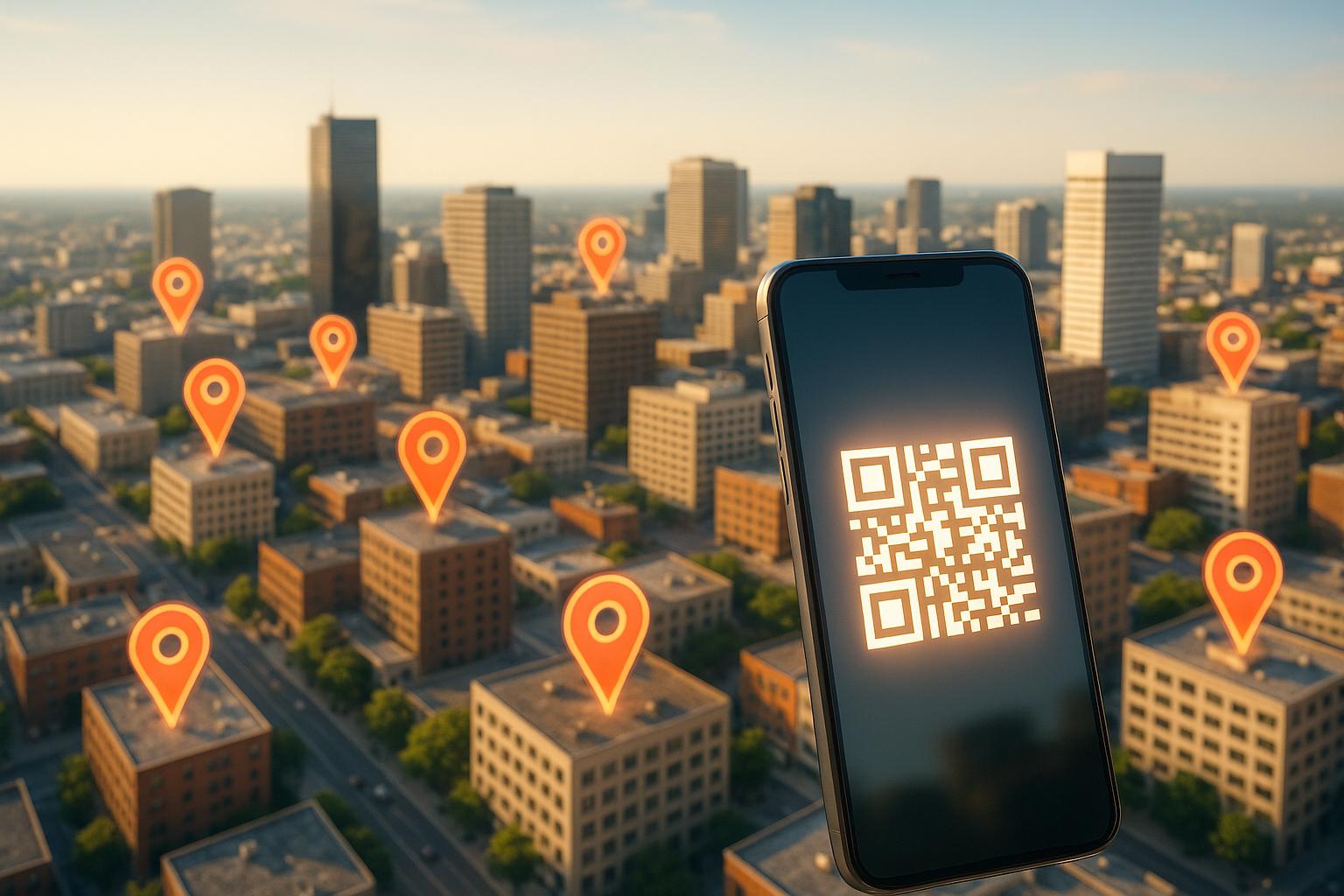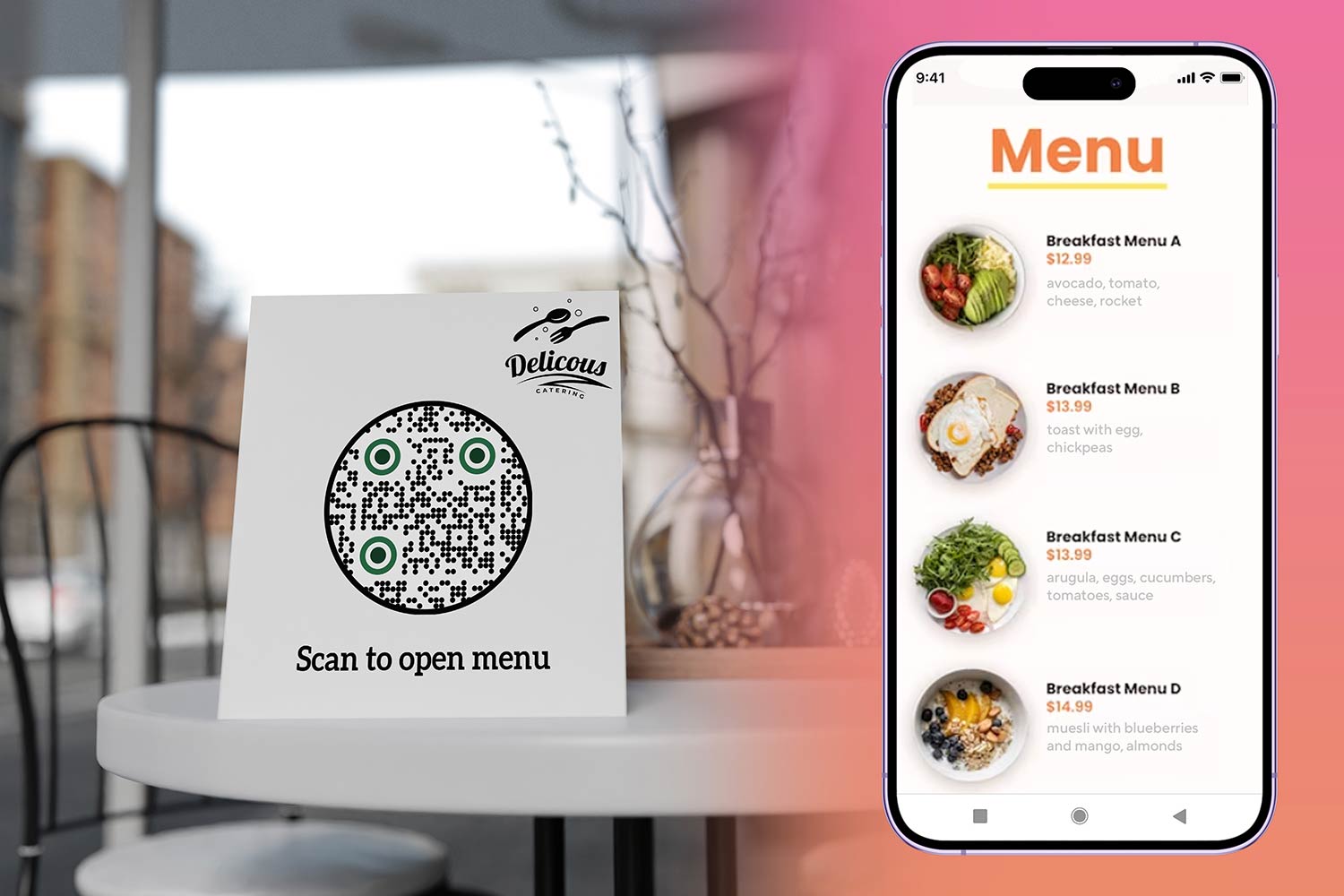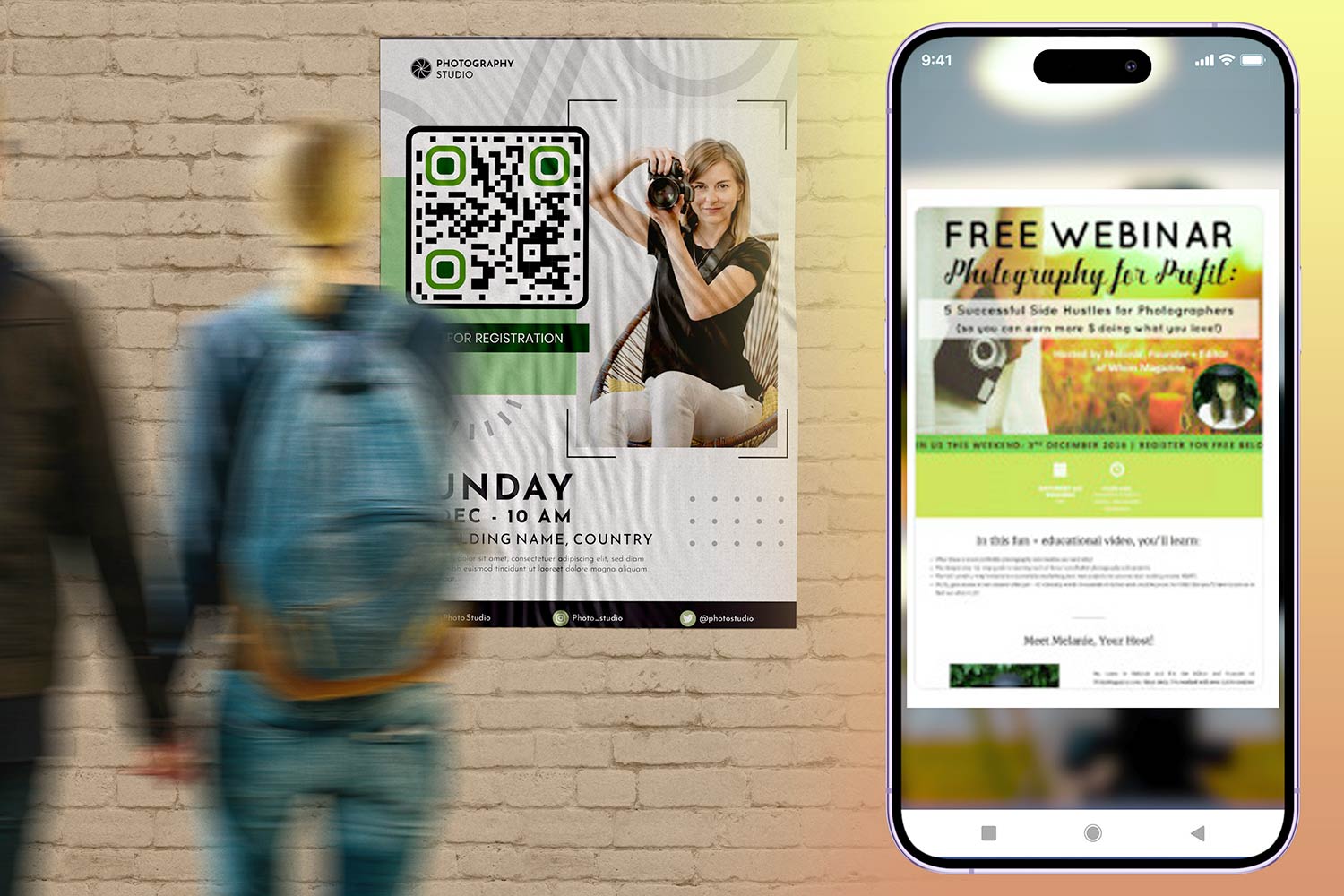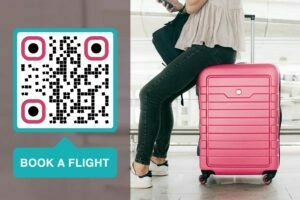Why do some QR code campaigns fail? They often deliver the same generic content to everyone, ignoring user location and context. This frustrates users and reduces engagement.
How can geolocation help? By using location data, businesses can create QR codes that deliver personalized, relevant content based on where and when they’re scanned. For example, a restaurant’s QR code can show a local menu in Miami and a different one in Seattle.
Key Takeaways:
- Dynamic QR Codes: Allow real-time updates and location-specific content.
- Geolocation Benefits: Tailor campaigns to user locations, boost engagement, and improve conversion rates by 15–25%.
- Analytics: Gather location-based insights to refine marketing strategies.
- Customer Loyalty: Delivering relevant, instant content builds trust and encourages repeat interactions.
Quick Comparison of QR Code Types:
| Feature | Static QR Codes | Dynamic QR Codes with Geolocation |
|---|---|---|
| Content Updates | Fixed forever | Real-time updates possible |
| Location Awareness | Same content everywhere | Different content per location |
| Analytics | No tracking | Location-based metrics |
Geolocation-powered QR codes are transforming marketing by making every scan a personalized experience.
How Do I Track The Location Of A QR Code Scan? – Marketing and Advertising Guru
How Geolocation Technology Improves QR Code Campaigns
Geolocation technology is changing the game for QR code marketing by making campaigns smarter and more context-aware. Instead of showing the same content to everyone, it uses real-time location data to create personalized experiences that connect with users on a deeper level. This approach turns static QR codes into dynamic marketing tools that adapt to where and when they’re scanned.
What Is Geolocation Technology?
Geolocation technology pinpoints a user’s physical location using GPS, Wi-Fi, or IP data. When someone scans a QR code, the system can instantly determine their location and deliver content tailored to that specific area. For instance, a dynamic QR code on a poster might show different information depending on whether it’s scanned in downtown Manhattan or another neighborhood. Marketers set these location-based rules in advance, ensuring the content aligns with the user’s surroundings.
This system works on a permission-based model, meaning users must allow location access for it to function. Businesses need to clearly explain the perks of granting access, such as showing nearby in-stock items or sharing local event details. Modern smartphones simplify this process by prompting users for location permissions during the scan. Once access is granted, the system delivers content that’s immediately relevant to the user’s location. This capability transforms static QR codes into dynamic tools.
Turning Static QR Codes Into Dynamic Tools
The distinction between static and dynamic QR codes becomes essential when integrating geolocation features. Static QR codes carry fixed information that can’t be altered after creation. In contrast, dynamic QR codes use a short URL that redirects to content that can be updated at any time. This flexibility allows a single QR code printed on thousands of flyers to deliver unique experiences based on where it’s scanned.
Dynamic QR codes, combined with geolocation, unlock a world of possibilities:
- Content Updates: Unlike static codes, dynamic codes allow real-time content changes.
- Location Awareness: Tailor content to specific locations.
- Analytics: Gather location-based metrics for better campaign insights.
| Feature | Static QR Codes | Dynamic QR Codes with Geolocation |
|---|---|---|
| Content Updates | Fixed forever | Real-time updates possible |
| Location Awareness | Same content everywhere | Different content per location |
| Analytics | No tracking | Location-based metrics |
The combination of dynamic QR codes and geolocation technology is where the real magic happens. For example, a real estate company can add QR codes to business cards that show properties available in the scanner’s area, making every interaction more meaningful.
This technology also shines in time-sensitive, location-targeted campaigns. Audi of America showcased this in June 2025 with a CTV/OTT campaign featuring dynamic QR codes. These codes displayed personalized content based on both location and time, resulting in a 93% video completion rate and over 23,000 extra minutes of brand engagement. It’s a clear example of how geolocation can elevate QR code marketing to new heights.
Key benefits of geolocation-based QR code campaigns
Geolocation-based QR code campaigns are a powerful way to connect with customers on a deeper level. By combining location intelligence with dynamic QR code technology, these campaigns deliver tailored, context-aware experiences that go far beyond a simple scan. They tackle the issue of generic messaging head-on, ensuring each interaction feels personalized and relevant. Let’s dive into how these campaigns create local connections, offer actionable insights, and boost customer loyalty.
Creating local and relevant campaigns
Tailoring content to a customer’s location can significantly impact campaign success. When someone scans a QR code and sees information directly tied to their surroundings, they’re much more likely to engage. In fact, over 90% of marketers report higher revenue and engagement when using location-based advertising.
The secret is offering content that aligns with local preferences. For instance, a restaurant chain can showcase region-specific menus, while a retail store might focus on products available nearby. Clear prompts encouraging users to share their location, such as “Share your location to see in-stock items at your nearest store,” consistently outperform vague requests. When the benefit is obvious, customers are more willing to opt in.
Brands like Starbucks and Nike have embraced this strategy to great success. Starbucks uses location-based QR codes in its app to deliver personalized rewards and promotions based on store proximity, driving both foot traffic and sales. Similarly, Nike enhances the in-store shopping experience by offering exclusive product details and customization options through location-specific QR codes.
This approach shines for time-sensitive offers too. A cafe can promote breakfast deals to morning commuters or happy hour specials to afternoon customers. By tailoring content to both location and time, businesses create a sense of urgency and exclusivity that encourages immediate action.
Using actionable analytics
Geolocation data elevates QR code analytics from basic metrics to strategic insights. Instead of just counting scans, businesses can analyze where and when scans happen, uncovering patterns that inform smarter decisions. This data can even enhance security through location-based fraud detection. For example, a 2025 gym wear campaign identified scan spikes near colleges after class hours, leading to hyper-targeted campaigns that boosted engagement and conversions.
Another example comes from a restaurant chain that distributed flyers with QR codes. Analytics revealed high scan activity in office-heavy areas, prompting the launch of targeted lunch promotions. The result? Increased foot traffic and higher lunchtime sales.
Geolocation data also highlights underperforming areas, allowing businesses to tweak their strategies. Whether it’s testing new offers or reallocating resources, this constant optimization ensures campaigns improve over time.
Beyond targeting, these insights refine customer engagement and foster stronger loyalty.
Boosting customer satisfaction and loyalty
Personalized experiences make customers feel valued and understood, which builds trust and encourages them to return. When a QR code delivers location-specific, relevant information instantly, it shows that a brand truly gets its audience.
L’Oreal exemplifies this with its “digital twins” initiative. QR codes on products in physical stores provide details about ingredients, expected results, and tutorials, helping customers make informed decisions. Meanwhile, Jameson’s “Jameson Connects” campaign links QR codes to exclusive content, early access to merchandise, and curated playlists, creating fun, engaging experiences that strengthen customer bonds.
Convenience is another major factor. Marriott Hotels use QR codes for mobile check-ins and member-only perks, streamlining the guest experience. Similarly, Sephora’s QR code-driven loyalty program offers tailored promotions and product recommendations, enhancing the shopping journey.
When customers can quickly find what they need – whether it’s local store hours, nearby inventory, or special promotions – they’re more likely to return. This creates a cycle where great experiences lead to loyalty, which generates valuable data to improve future interactions.
A 2024 survey found that 42% of consumers prefer a direct, one-step process after scanning a QR code, while 34% are willing to take additional steps if the information is worthwhile.
This highlights that when content is relevant and personalized, customers are more willing to engage deeply with the brand.
How Pageloot Enables Advanced QR Code Personalization

Pageloot takes the potential of geolocation to the next level by offering businesses a robust platform to create, customize, and manage QR code experiences tailored to user locations and preferences. Supporting over 25 types of QR codes and featuring advanced customization tools, Pageloot makes it simple to launch intricate campaigns without requiring technical expertise. This approach combines adaptive content with actionable insights, enhancing the benefits of geolocation.
Dynamic QR Codes for Real-Time Personalization
Unlike static QR codes that are locked to a single destination, Pageloot’s dynamic QR codes allow for real-time updates and location-based redirection after publication. For instance, a retail chain could use a QR code for a holiday campaign and adjust its destination URL to reflect local inventory or promotions as they change. Imagine a restaurant chain directing morning scanners to breakfast menus and afternoon visitors to lunch specials, or an e-commerce business showcasing products available for same-day delivery.
These dynamic capabilities, paired with detailed analytics, empower businesses to fine-tune their campaigns for maximum impact.
Advanced Analytics for Smarter Campaigns
Pageloot’s analytics turn scan data into valuable insights. The platform provides detailed metrics like location, scan times, and device types, enabling businesses to continuously improve campaign performance. For example, a marketing agency can use these insights to showcase ROI across different campaigns, while a real estate firm might allocate marketing budgets more effectively based on geographic interest. Additionally, device-specific data helps guide mobile-friendly design, ensuring a seamless user experience.
Customization and Branding Options
A visually appealing and brand-consistent QR code can make all the difference in a campaign’s success. Pageloot offers extensive customization options, including logos, colors, and call-to-action frames, ensuring every scan reflects the brand’s identity . For location-specific campaigns, customization becomes even more impactful.
For example:
- A cafe chain could use seasonal color schemes or add unique elements for specific locations.
- A construction company might brand QR codes on vehicles with project-specific details.
Pageloot also allows businesses to create QR codes that link directly to locations via Google Maps. Whether printed on business cards, flyers, or product labels, these QR codes maintain brand consistency while delivering personalized, location-aware experiences.
sbb-itb-74874c9
Steps to launch a geolocation-based QR code campaign
Launching a geolocation-based QR code campaign involves careful planning, seamless execution, and ongoing monitoring. Here’s how you can navigate through the process effectively.
Defining campaign goals and target locations
Start by outlining your campaign’s primary objectives. Are you aiming to increase foot traffic, boost online sales, or improve brand visibility? These goals will shape your approach and strategy. Keep in mind that customer behavior often varies by location. For instance, a coffee shop in a business district might focus on attracting morning commuters, while one near a university may cater to students throughout the day.
Identify the locations where your target audience is most likely to engage with your campaign. These spots may not necessarily align with your business’s physical location. For example, a marketing agency might focus on displaying QR codes at networking events or co-working spaces where potential clients are likely to gather.
When setting geographic boundaries, begin with smaller radii – 100 to 200 meters – during testing to ensure the targeting works accurately. Maintain consistency in language and location settings throughout your campaign. Since location targeting depends on signals like user settings, device data, and behavior patterns, it’s crucial to factor these into your planning.
Be transparent about the benefits of sharing location data, as this can encourage users to grant permission. Once your goals and target areas are clearly defined, move on to designing QR codes tailored to your local strategy.
Creating and customizing QR codes with Pageloot
With your campaign goals and locations set, the next step is to create QR codes that align with your strategy. Pageloot offers dynamic QR codes that update in real time based on location data.
Choose from over 25 QR code types to suit your campaign’s needs. For example, a restaurant chain might use menu QR codes that display different items depending on the time of day and location. Similarly, a retail business could use link QR codes to direct customers to location-specific landing pages showcasing local inventory and deals.
Customizing your QR codes is key to making them stand out. Incorporate your company’s logo, colors, and branding elements to create a consistent and professional look. Pageloot’s pre-designed templates can help maintain visual appeal while tailoring the design to fit local contexts.
Placement is equally important. Ensure QR codes are visible and easy to scan. For example:
- On business cards, make the code large enough for effortless scanning.
- On flyers or posters, position them in high-traffic areas.
- For outdoor use, consider larger QR codes, while curved surfaces like bottles may require special sizing.
Provide simple, clear instructions on how to scan the code, and consider adding incentives like discounts or exclusive content. A strong call-to-action, such as "Scan to save 20% on local items", is far more effective than generic prompts.
Once your QR codes are ready, deploy them strategically and track their performance to refine your campaign.
Deploying and monitoring campaign performance
Strategic placement is crucial. Position QR codes in high-traffic areas and adjust their size to suit the environment – larger codes for outdoor banners, smaller ones for curved surfaces.
Make sure your landing pages are optimized for mobile devices, as most QR codes are scanned via smartphones. To encourage long-term engagement, consider offering a promotion in exchange for signing up for your newsletter.
Use Pageloot’s analytics to monitor your campaign in real time. The platform provides detailed insights, such as scan locations, device types, and time-based trends, offering a level of analysis that static QR codes cannot match.
"The only way to measure the effectiveness of a marketing strategy is through analytics. The same goes for QR codes".
Take inspiration from real-world examples. In March 2025, a skincare brand using QR codes on product packaging discovered higher engagement in humid regions, prompting them to introduce moisture-focused product lines. Similarly, a clothing retailer found that 60% of QR code scans occurred on weekends, leading to the success of weekend-only flash sales.
Regularly reviewing analytics can reveal patterns in user behavior. For instance, a hotel using QR codes for local attraction guides noticed that tourists from specific countries scanned the codes more frequently. This insight allowed the hotel to offer travel guides in multiple languages, tailored to their audience.
Conclusion: Why Geolocation Is the Future of QR Code Marketing
Geolocation takes QR codes from being simple tools to becoming highly personalized marketing assets, changing the way businesses connect with their audience.
With 59% of consumers scanning QR codes daily and QR-initiated journeys achieving a 37% average click-through rate, the groundwork for widespread use is already set. Even more compelling, 95% of businesses report that QR codes help them gather valuable first-party data.
As 39% of customers now expect personalized QR code content and over 90% of marketers see increased revenue from location-based advertising, delivering context-aware experiences is no longer optional – it’s necessary. Companies that fail to adapt risk losing customer engagement to competitors who prioritize personalization.
QR codes are evolving fast. They now integrate AI-driven analytics, augmented reality features, and secure mobile payment options. With mobile payments projected to surpass $2.7 trillion globally by 2025, QR codes are set to remain at the center of this growth. The success of these advancements is already evident in real campaigns. For example, PepsiCo’s 2023 Super Bowl effort saw 20% higher engagement compared to traditional campaigns, while Starbucks’ contactless ordering system drove a 50% increase in QR code usage.
The trend toward personalized, location-specific marketing is clear. Businesses that adopt geolocation-powered QR code strategies now will gain a competitive edge. These innovations align with the earlier discussion on how personalization enhances customer engagement and fosters stronger connections.
Platforms like Pageloot make it easy to create these advanced campaigns. Their tools, such as dynamic QR code generators, allow businesses to update content in real time based on location data, ensuring every scan delivers relevant and engaging experiences.
As QR code usage continues to grow – projected to hit 41.77 million scans by 2025 – geolocation technology offers a way for businesses to stand out in this expanding market. By embracing geolocation now, companies can transform every scan into an opportunity for meaningful interaction.
FAQs
How does geolocation make QR code campaigns more personalized and effective?
How Geolocation Enhances QR Code Campaigns
Geolocation technology takes QR code campaigns to the next level by tailoring content to a user’s physical location. Imagine scanning a QR code and instantly seeing offers, promotions, or updates that are specific to where you are – whether it’s a discount at a nearby store or event details for your current city. This kind of localized approach makes the content feel more relevant, which naturally boosts user engagement.
Dynamic QR codes make this even more powerful. They allow businesses to update the content displayed in real time based on the scan’s location. This means marketers can craft campaigns that are not only highly targeted but also adaptable, ensuring users get information that resonates with them in the moment. It’s a smart way to create a smoother, more personalized experience.
How can businesses encourage users to enable location access for geolocation-based QR code campaigns?
To get users to enable location access, businesses should aim for a user-friendly and straightforward approach. Start by placing QR codes in spots that are easy to see and frequently visited. Make sure these codes are not only simple to scan but also visually appealing. Pair them with clear, attention-grabbing calls to action that highlight the perks – like access to exclusive discounts, tailored suggestions, or content tied to their location.
Equally important is building trust. Be upfront with users by sharing transparent privacy policies and explaining exactly how their location data will be used. Reassure them by showcasing the security measures in place and emphasizing that their data won’t be misused. When you combine this transparency with a smooth scanning process, you’ll create a more engaging and trustworthy experience, encouraging more users to participate in your campaigns.
How can businesses use geolocation analytics from QR codes to improve their marketing strategies?
Businesses can use geolocation analytics from QR codes to better understand customer behavior. By monitoring where and when their QR codes are scanned, companies can pinpoint high-traffic areas, identify peak times for engagement, and uncover regional preferences. This kind of data allows businesses to fine-tune their campaigns, customizing content for specific locations and adjusting schedules to achieve stronger results.
Geolocation data also plays a key role in targeted marketing. For example, businesses can tweak promotions to align with regional trends or allocate more resources to areas with higher engagement rates. These insights enable smarter, data-driven decisions, helping to boost campaign performance and get the most out of marketing investments.

























